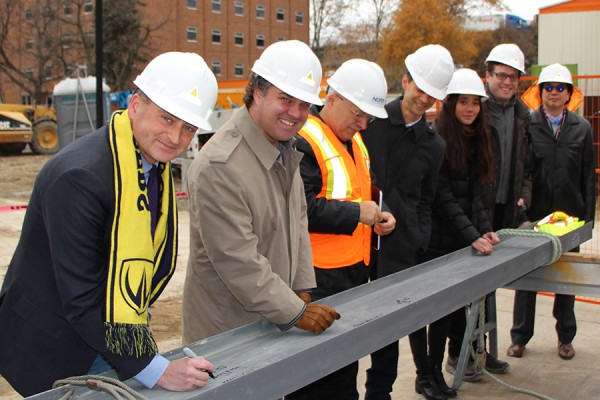 Julia Borsatto, UWindsor clinical neuropsychology graduate student, and Laura Pineault (B.Sc. 2016) are associate directors of Aphasia Friendly Canada.
Julia Borsatto, UWindsor clinical neuropsychology graduate student, and Laura Pineault (B.Sc. 2016) are associate directors of Aphasia Friendly Canada.
There are few things more dispiriting than losing the ability to communicate. And yet, every year, thousands of people across Canada awake to a new reality filled with elusive words and illegible text.
It’s this growing population that a team from the University of Windsor has set out to provide with a new voice and a new lease on life.
“Losing the ability to communicate can make a person feel lonely, depressed and make it difficult to seek help,” said UWindsor psychology professor Lori Buchanan. “More than 25 per cent of stroke patients are diagnosed with aphasia, which is caused by brain damage and creates some inability to process language.”
Aphasia Friendly Canada is a project from the University’s Cognitive Neuroscience Laboratory and is operated by Dr. Buchanan, Julia Borsatto, and Laura Pineault. The neurological disorder is more prevalent than cerebral palsy, multiple sclerosis, Parkinson’s disease and muscular dystrophy, and yet it’s a condition that is largely unknown to the general public.
“When you are diagnosed with aphasia there is often this loss of autonomy,” Pineault explained. “Many people have likely encountered a person with aphasia but don’t interact directly with them because they go out with a caregiver.
“We would like to give them that sense of autonomy back.”
Pineault first presented the idea for this project two years ago during the Council of Ontario Universities’ Innovative Designs for Accessibility competition, where she was the UWindsor entrant. Since then, she and other members of Buchanan's lab have created toolkits to assist businesses in becoming aphasia-friendly and founded support groups for those with aphasia and their caregivers.
In Windsor and Essex County, 17 businesses are participating in the program and can be identified by the "Aphasia Friendly" sticker in the window.
“Our team goes out into the community and works with businesses to teach them what aphasia is, how they can better communicate with someone with aphasia and provide them with custom materials,” Buchanan said.
She said local Tim Hortons owner Pat Hayes has enthusiastically enrolled all 13 of his restaurants.
“We give signs to these businesses and created nonverbal menus for them to use in their stores,” Buchanan said. “A benefit of this is that not only will you know how to communicate with people who can no longer speak, but you can now communicate with anyone who can’t speak English.”
Along with the intrinsic benefits to increased businesses, Buchanan said all businesses will be required to be aphasia-friendly once the Accessibility for Ontarians with Disabilities Act is enforced in 2025.
“Right now, we are offering this service for free, but eventually businesses will have to pay for this,” she said.
The team is also hoping to connect with municipalities and first responders.
Borsatto, who began graduate study in clinical neuropsychology this fall, trained the City of Burlington’s parks and recreation over the summer.
“To offer hands-on training for the employees, we took a group of people with aphasia to a pool where they knew everyone at the customer service desk and lifeguards would be cognizant of what aphasia is and knew how to support conversations,” Borsatto said.
According to the Ontario Stroke Network, there are about 426,000 Canadians living with the effects of a stroke and about 50,000 new strokes in Canada every year. With about 25 to 40 per cent of stroke survivors acquiring aphasia, Buchanan said it’s vital for the region to improve its supports.
“Windsor is selling itself as a retirement destination, and with an older population you are more likely to get more people with aphasia,” she said.
Pineault said southwestern Ontario is a “blackout zone” for aphasia supports, but she hopes this program will help change that.
“We are helping businesses to be compliant, but we are also helping people with aphasia improve their quality of life,” she said. “We are working with Windsor Regional Hospital’s stroke navigator, and when someone wakes up with aphasia, we want them to know that they are supported and that there are businesses here that will be accessible for people with communication disorders.”
For more information about the program, or to enrol, visit www.AphasiaFriendlyCanada.ca.




 The logo is available here for download
The logo is available here for download


